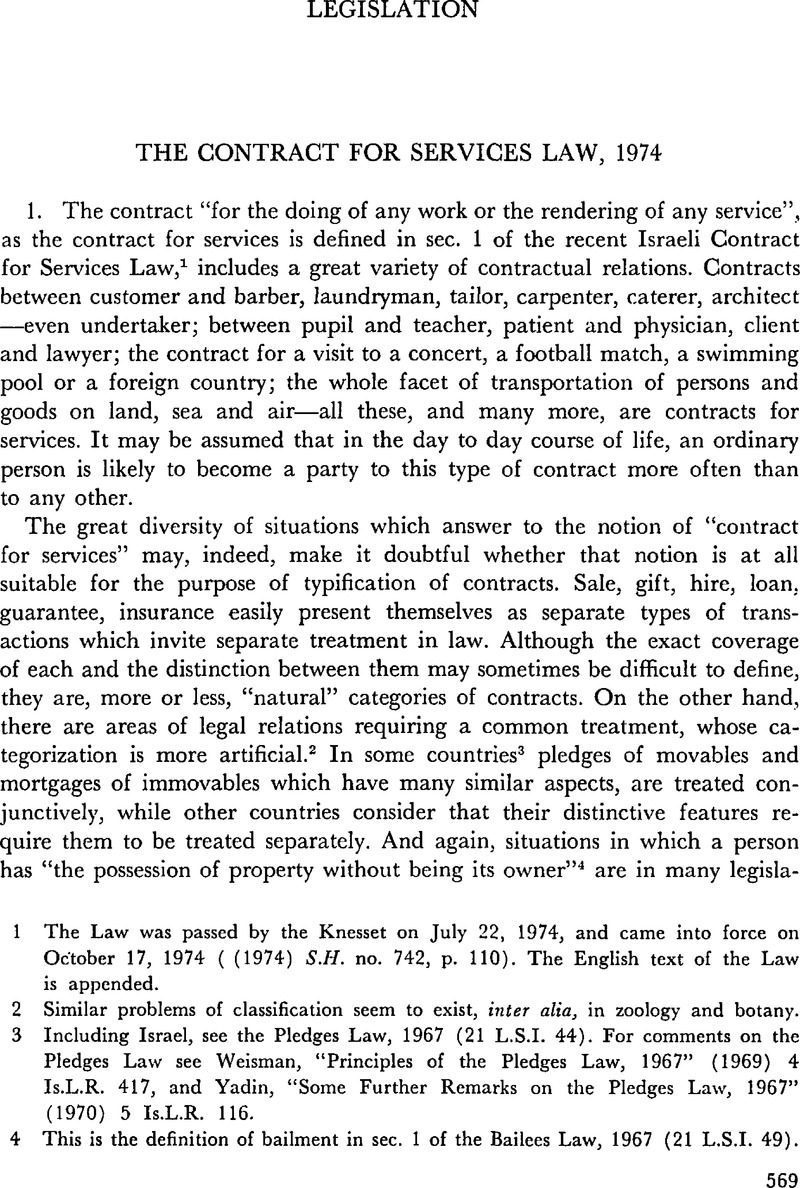Article contents
The Contract for Services Law, 1974
Published online by Cambridge University Press: 12 February 2016
Abstract

- Type
- Legislation
- Information
- Copyright
- Copyright © Cambridge University Press and The Faculty of Law, The Hebrew University of Jerusalem 1975
References
1 The Law was passed by the Knesset on July 22, 1974, and came into force on October 17, 1974 ( (1974) S.H. no. 742, p. 110). The English text of the Law is appended.
2 Similar problems of classification seem to exist, inter alia, in zoology and botany.
3 Including Israel, see the Pledges Law, 1967 (21 L.S.I. 44). For comments on the Pledges Law see Weisman, , “Principles of the Pledges Law, 1967” (1969) 4 Is.L.R. 417Google Scholar, and Yadin, , “Some Further Remarks on the Pledges Law, 1967” (1970) 5 Is.L.R. 116.CrossRefGoogle Scholar
4 This is the definition of bailment in sec. 1 of the Bailees Law, 1967 (21 L.S.I. 49).
5 See preceding note.
6 22 L.S.I. 107. See Aronovsky, , “Comments on the New Law of Sales” (1969) 4 Is.L.R. 141.Google Scholar
7 25 L.S.I. 152.
8 27 L.S.I. 117, hereinafter “General Part Law”. See Shalev, G., “General Comments on Contracts (General Part) Law, 1973” (1974) 9 Is.L.R. 274.Google Scholar
9 25 L.S.I. 11, hereinafter “Remedies Law”. See Shalev, G., “Remedies on Anticipatory Breach” (1973) 8 Is.L.R. 123.Google Scholar
10 Sec. 39.
11 See the recent opinion of Kister J. in Parcel 677 Ltd. v. Cohen (1975) (I) 29 P.D. 365.
12 This is contrary to the approach of the Movable Property Law, 1971 (25 L.S.I. 175) where, with regard to the mixture and processing of movables belonging to different persons, the value of work has been compared to the value of property (sees. 4, 6).
13 The second part of sec. 1, distinguishing the contract for services from the contract of labour, has been commented on above.
14 Unlike sec. 3 (2) of the Remedies Law which is confined to “personal” services.
15 22 L.S.I. 113. See Landau, and Rakover, , “The Gift Law, 1968” (1969) 4 Is.L.R. 260.Google Scholar
16 Israel has ratified the Hague Convention and enacted the Uniform Law, see Sale (International Sale of Goods) Law, 1971 (25 L.S.I. 32).
17 It is in line with the tendency of the new legislation to discard artificial distinctions wherever it is feasable. Thus, in the Succession Law, 1965 (19 L.S.I. 58), the distinction between administrator (of an estate) and executor (of a will) has been abolished. Cf. Yadin, , “Reflections on a New Law of Succession” (1966) 1 Is.L.R. 132Google Scholar, and also Elman, , “The Succession Law, 1965: A Lustrum” (1972) 7 Is.L.R. 286.CrossRefGoogle Scholar The Contract (General Part) Law, in its rules on mistake (sec. 14) has refrained from distinguishing between the various traditional categories of mistakes and also between mistake of fact and mistake of law. The lack of distinction between work and service is also in point.
18 But the customer's duty to notify the contractor of the defect extends also to those cases.
19 In addition, of course, to his remedies under the Remedies Law.
20 The Lease Law also has a provision for the release of the lessee of immovable property from his duty to pay the rent if his enjoyment of the premises has been frustrated (sec. 15).
21 25 L.S.I. 175.
22 See infra, part 4 and part 5. The problem of removal exists also in the case of the sale of bulky objects. The Sales Law deals with it in a more peremptory manner by providing, in sec. 19, that the purchaser is bound “to receive the object of the sale”.
23 Sec. 32 and sec. 20, respectively, of those Laws.
24 21 L.S.I. 49.
25 However, a similar reference has been made in sec. 24 of the Lease and Loan Law for the purpose of describing the lessee's liability for loss of or damage to the object on lease. This somewhat cumbersome technique has been employed in order to secure the application to the possession of the lessee or contractor not only of the basic rules of liability contained in the Bailees Law, but also of the complementary provisions of that statute.
26 The latter provision, in turn, is based on the Uniform Law on the International Sale of Goods, art. 96–98 (25 L.S.I. 53).
27 In England and the United States this means the law made by the judges of the country itself, while in Palestine and Israel it meant the law made abroad, by the judges of England. See Friedmann, , “Infusion of the Common Law into the Legal System of Israel” (1975) 10 Is.L.R. 324.Google Scholar
28 See, inter alia, Yadin, , “The New Statute Law of Contracts” (1974) 9 Is.L.R. 512.Google Scholar
29 In due course the statute will be interpreted judicially and thus the law relating to contracts for services will consist of the statute together with the new precedents. But on its enactment the statute stands all on its own, detached from previous and foreign case law.
- 1
- Cited by




